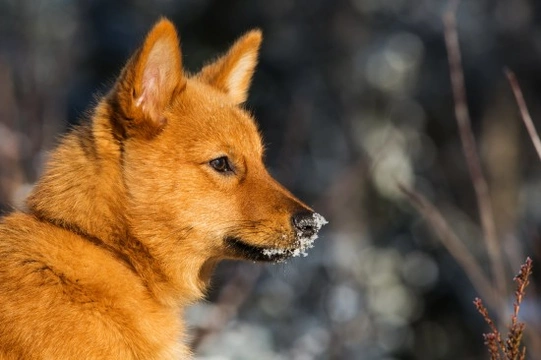
Is the Finnish spitz dog a good domestic pet?
The Finnish spitz originates in Finland, as the name suggests, where they were originally bred to hunt game animals ranging from small pests such as the rat and squirrel, right up to bears, moose and other large prey at the top end of the scale!
They are one of the few breeds of dog that is classified as a “bark pointer,” meaning that when the dog identifies and homes in on prey, they will bark to alert their handler to the presence of the other animal. The presence of the barking dog also means that the prey animal will usually focus on the dog and not the handler, allowing the handler to get in close to the animal to make the kill.
Within Finland, the Finnish spitz is still kept mainly as a working dog, and is actually recognised as the national dog of Finland. They are also incredibly friendly, personable and affectionate, which makes them a good candidate for non-working domestic life in some cases.
If you are wondering if a Finnish spitz dog might be the right choice of pet for you, and how well they can fit into a domestic lifestyle, we will address these points in more detail in this article. Read on to learn more.
What does the Finnish spitz dog look like?
The Finnish spitz dog is rather fox-like in appearance, with a gingery-red fox colouration, a rather pointed face with triangular ears, and a bushy, curled tail. They are classed as small to medium sized, and are slightly taller than they are long. Females stand up to 18” tall, and males up to 20” tall, and they can weigh up to 30lb.
They are double coated and shed a moderate amount all year round, and will blow their coats a couple of times a year, resulting in very heavy shedding for a couple of weeks at a time.
Are they easy to train?
The Finnish spitz is a very active, lively dog that is alert and watchful and into everything! They require a reasonable amount of mental stimulation as well as lots of exercise, needing at least a couple of long, active walks per day. They do not do well with rigorously structured, repetitive training or spending a lot of time by themselves, but they can learn and retain complex commands when schooled by means of positive reinforcement training that is kept varied and interesting to hold the dog’s attention.
They can be prone to stubbornness, and will soon gain the upper hand with an inexperienced or inconsistent trainer!
Do they have strong hunting instincts?
The Finnish spitz is essentially a hunting breed, and as a bark pointer, they will soon display their hunting and bark pointing instincts without any training to do so. This means that they will not make any distinction between potential prey and small domestic animals such as cats, and as such, they need to be carefully managed when outside of the home in order to keep other animals safe. It is not unheard of for the Finnish spitz to be able to share their home safely with cats, but this does require careful introductions and management when the dog is young.
Even if your Finnish spitz is fine with your cat within the home, you should not assume that this will prevent the dog from chasing other cats when out and about, given the chance!
Do they get on well with children?
The Finnish spitz is a very personable dog that is particularly noted to get on well with children of all ages, and enjoy games and outdoor play with kids. They will soon learn who is likely to want to play with them and instigate play, but they also soon learn when someone is not in the mood and will leave them to their own devices in favour of making their own entertainment!
They are rather independent, and tend to bond strongly with their families, but take a while to warm up to strangers. While they can be rather aloof with people that they don’t know and may be wary of newcomers, they tend to be protective rather than aggressive when put on the spot.
Are they healthy and hardy?
The average lifespan of the Finnish spitz is just over eleven years, and they are generally regarded as a robust and healthy breed of dog that is not particularly fragile or prone to contracting minor ills.
However, there are a few hereditary health conditions that can affect the Finnish spitz, although their prevalence is not as high within this breed as they are in many others.
Some of the most common health issues seen within the Finnish spitz gene pool are epilepsy, patellar luxation, hip dysplasia and elbow dysplasia. Pre-breeding testing can be undertaken to identify risk factors for some of these conditions, but as none of them are hugely prevalent across the breed as a whole, no standardised testing is considered to be the norm for professional Finnish spitz breeders.



